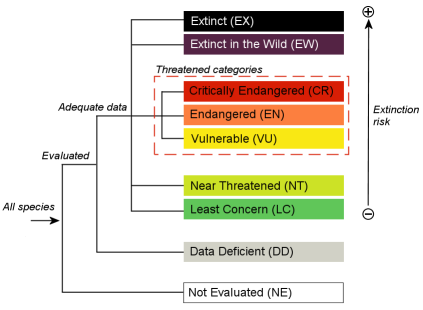The IUCN Species Programme working with the IUCN Species Survival Commission (SSC) has for more than four decades been assessing the conservation status of species, subspecies, varieties, and even selected subpopulations on a global scale in order to highlight taxa threatened with extinction, and therefore promote their conservation. Although today we are operating in a very different political, economic, social and ecological world from that when the first IUCN Red Data Book was produced, the IUCN Species Programme, working with the Species Survival Commission and many partners, remains firmly committed to providing the world with the most objective, scientifically-based information on the current status of globally threatened biodiversity. The plants and animals assessed for the IUCN Red List are the bearers of genetic diversity and the building blocks of ecosystems, and information on their conservation status and distribution provides the foundation for making informed decisions about conserving biodiversity from local to global levels.
The IUCN Red List of Threatened Species™ provides taxonomic, conservation status and distribution information on plants and animals that have been globally evaluated using the IUCN Red List Categories and Criteria. This system is designed to determine the relative risk of extinction, and the main purpose of the IUCN Red List is to catalogue and highlight those plants and animals that are facing a higher risk of global extinction (i.e. those listed as Critically Endangered, Endangered and Vulnerable). The IUCN Red List also includes information on plants and animals that are categorized as Extinct or Extinct in the Wild; on taxa that cannot be evaluated because of insufficient information (i.e., are Data Deficient); and on plants and animals that are either close to meeting the threatened thresholds or that would be threatened were it not for an ongoing taxon-specific conservation programme (i.e., are Near Threatenedi).

Plants and animals that have been evaluated to have a low risk of extinction are classified as Least Concern. The Least Concern assessments did not appear on IUCN Red Lists produced before 2003 (except for a few that were listed in 1996) because the main focus of attention has been on threatened species. However, for the sake of transparency and to place threatened assessments in context, all Least Concern assessments are now included on the IUCN Red List. Thus, despite its title, The IUCN Red List of Threatened Species™ does not just focus on threatened species; it considers the status of all species across an increasing number of taxonomic groups. In the past, there has unfortunately been no formal reporting process to capture all the Least Concern assessments; hence the list of Least Concern species on the IUCN Red List is not comprehensive (i.e., many species have been assessed to be Least Concern, but as that information was never formally captured, the listings do not appear on the Red List).
The IUCN Species Programme maintains the information behind the IUCN Red List in a centralized database as part of the Species Information Service (SIS). An extract of that information is made publicly available via a searchable database on this web site The records for all plants and animals listed in the Red List Categories described above are accessible here and they can be viewed by using the Search function on the home page.
Only a small number of the world's plant and animal species have been assessed. In addition to the many thousands of species which have not yet been assessed (i.e., are Not Evaluated), other species that are not included on the IUCN Red List are those that went extinct before 1500 AD and Least Concern species that have not yet been data based. The species groups that have been comprehensively assessed include the amphibians, birds, mammals, freshwater crabs, warm-water reef building corals, conifers and cycads. The vast majority of plants listed in the 1997 IUCN Red List of Threatened Plants have not yet been evaluated against the revised Red List Criteria and are therefore not included here.
In-depth analyses of the data contained in the IUCN Red List are published periodically (usually at least once every four years). The results from the analysis of the data contained in the 2008 update of the IUCN Red List are published in The 2008 Review of the IUCN Red List of Threatened Species; see www.iucn.org/redlist for further details.